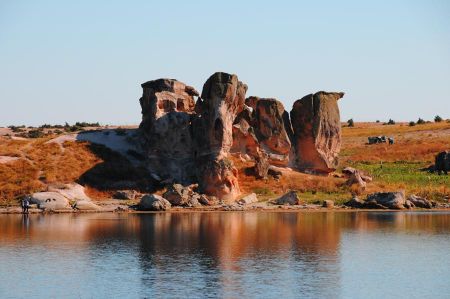The Phrygian Valley at Afyon Karahisar
- Written by Portal Editor
We had heard several times about the second tufa region, comparable to Cappadocia, the Phrygian Valley (Frig Vadisi), but so far without ever having visited the area around Afyon.
Once again in Afyon, we used the free day coming out of the city to drive via Cayirbag and Gazlikoy on a short visit to the Phrygian Valley. It is just 20 kilometers to get there and then on a circular route peppered with a large number of handsome, antique relics, about 80 kilometers via Döğer (near İhsaniye), via Alanyurt to Seydiler and back. A really worthwhile short trip with a variety of tuff fairy chimneys (Peri Bacalari), rock-cut dwellings, rock-cut tombs and Phrygian monuments.
Gordion on the Sangarios River
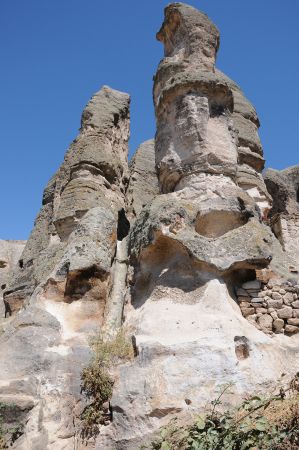 The valley is named after the Phrygians, a tribe that reached its heyday under King Midas in the 8th century BC. From around the 12th century BC, the Phrygians, originally from Troas and Thrace, settled in this region, which once belonged to the Hittite empire. In the course of the following centuries, the Phrygians were able to conquer large parts of the former Hittite empire and thus also rise to become a large empire. Legendary are some of the myths surrounding King Midas, who was able to raise the kingdom, with its capital in Gordion on the Sangarios River, about 80 kilometers from present-day Ankara, to the peak of Phrygian power. Another center was Kelainai in the south of Phrygia, which later served as a residence for the Persian kings and which, after Ephesus, rose to become the most important market location in Asia Minor under the Romans. Just 80 years later, the Cimmerians invaded Midas' sphere of influence and were even able to conquer the capital Gordion. However, the culture of the Phrygians continued to exist in the following centuries.
The valley is named after the Phrygians, a tribe that reached its heyday under King Midas in the 8th century BC. From around the 12th century BC, the Phrygians, originally from Troas and Thrace, settled in this region, which once belonged to the Hittite empire. In the course of the following centuries, the Phrygians were able to conquer large parts of the former Hittite empire and thus also rise to become a large empire. Legendary are some of the myths surrounding King Midas, who was able to raise the kingdom, with its capital in Gordion on the Sangarios River, about 80 kilometers from present-day Ankara, to the peak of Phrygian power. Another center was Kelainai in the south of Phrygia, which later served as a residence for the Persian kings and which, after Ephesus, rose to become the most important market location in Asia Minor under the Romans. Just 80 years later, the Cimmerians invaded Midas' sphere of influence and were even able to conquer the capital Gordion. However, the culture of the Phrygians continued to exist in the following centuries.
Rock tombs from the Byzantine period
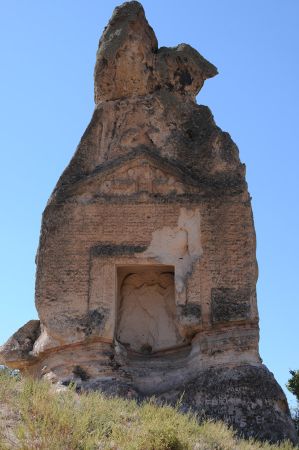 Hardly any signage and little firm road surfaces are probably two of the reasons why the Phrygian Valley has so far received so little attention from the tourist side. We ask the rural population, partly on well-worn sand tracks, to find some of the relics at all. We already decide to bring a navigation device with us when we visit the Phrygian Valley again, otherwise we would hardly be able to go to the points again. We encounter settlements hewn into the rock, which were inhabited until the Byzantine period. In Isehisar there are pointed rock formations (Karakaya and Kirkiler) and rock tombs from the Byzantine period. In addition, monasteries, churches and houses from the early days of Christianity. Near Ayazini lies the ancient city of Metropolis and other rock churches from the Roman-Byzantine period, as well as the ruins of Avdalaz Castle.
Hardly any signage and little firm road surfaces are probably two of the reasons why the Phrygian Valley has so far received so little attention from the tourist side. We ask the rural population, partly on well-worn sand tracks, to find some of the relics at all. We already decide to bring a navigation device with us when we visit the Phrygian Valley again, otherwise we would hardly be able to go to the points again. We encounter settlements hewn into the rock, which were inhabited until the Byzantine period. In Isehisar there are pointed rock formations (Karakaya and Kirkiler) and rock tombs from the Byzantine period. In addition, monasteries, churches and houses from the early days of Christianity. Near Ayazini lies the ancient city of Metropolis and other rock churches from the Roman-Byzantine period, as well as the ruins of Avdalaz Castle.
Adonis is based on Phrygian origins
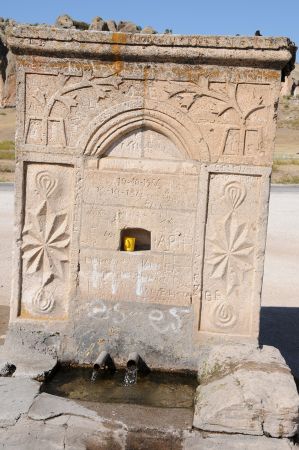 A little further along our circular path we come across rock tombs from Phrygian and Hittite times. Here it is primarily the towns of Aslantas and Yilantas that attract our special attention with their Phrygian rock chamber tombs and lion depictions. At Aslankaya we find a Phrygian monument to Cybele, the pre-eminent deity of the Phrygians, whose most important cultural center was in Pessinus (about 130 kilometers west of Ankara with the Cybele sanctuary). Like many other figures of gods, Cybele was taken over by the Romans. When the symbol of the goddess reached Rome via Pergamon with the delivery of the black meteorite, the cult of Cybele grew stronger and stronger until it achieved the status of "Magna Mater". Some mystics today even say that the myth of Adonis is based on Phrygian origins. The Phrygian cult facade of Malta is also worth seeing.
A little further along our circular path we come across rock tombs from Phrygian and Hittite times. Here it is primarily the towns of Aslantas and Yilantas that attract our special attention with their Phrygian rock chamber tombs and lion depictions. At Aslankaya we find a Phrygian monument to Cybele, the pre-eminent deity of the Phrygians, whose most important cultural center was in Pessinus (about 130 kilometers west of Ankara with the Cybele sanctuary). Like many other figures of gods, Cybele was taken over by the Romans. When the symbol of the goddess reached Rome via Pergamon with the delivery of the black meteorite, the cult of Cybele grew stronger and stronger until it achieved the status of "Magna Mater". Some mystics today even say that the myth of Adonis is based on Phrygian origins. The Phrygian cult facade of Malta is also worth seeing.
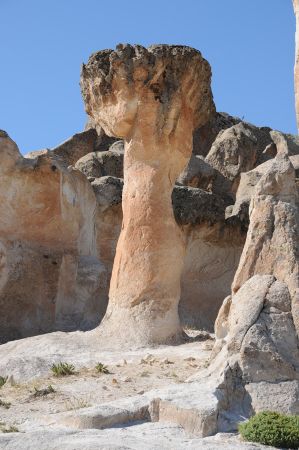 In the village of Döğer-İhsaniye we meet the rock settlements Demirli and Bayramaliler Kalisi, which are considered an important meeting place of the Emre dervishes from the early days of Islam.
In the village of Döğer-İhsaniye we meet the rock settlements Demirli and Bayramaliler Kalisi, which are considered an important meeting place of the Emre dervishes from the early days of Islam.
At Emre Gölü we meet locals again who meet their neighbors there for barbeque and fishing. We follow their invitation, stay with them a little and are very happy about it afterwards, because we now get good directions back towards Afyon, so that the way back is possible without further questions.
Please read as well:
Afyonkarahisar – Old City and the Black Castle
Eber Gölü - swampland and bird paradise again
-
 Afyonkarahisar at Phryger Valley
Afyonkarahisar at Phryger Valley
Afyonkarahisar at Phryger Valley
Afyonkarahisar at Phryger Valley
-
 Afyonkarahisar at Phryger Valley
Afyonkarahisar at Phryger Valley
Afyonkarahisar at Phryger Valley
Afyonkarahisar at Phryger Valley
-
 Afyonkarahisar at Phryger Valley
Afyonkarahisar at Phryger Valley
Afyonkarahisar at Phryger Valley
Afyonkarahisar at Phryger Valley
-
 Afyonkarahisar at Phryger Valley
Afyonkarahisar at Phryger Valley
Afyonkarahisar at Phryger Valley
Afyonkarahisar at Phryger Valley
-
 Afyonkarahisar at Phryger Valley
Afyonkarahisar at Phryger Valley
Afyonkarahisar at Phryger Valley
Afyonkarahisar at Phryger Valley
-
 Afyonkarahisar at Phryger Valley
Afyonkarahisar at Phryger Valley
Afyonkarahisar at Phryger Valley
Afyonkarahisar at Phryger Valley
-
 Afyonkarahisar at Phryger Valley
Afyonkarahisar at Phryger Valley
Afyonkarahisar at Phryger Valley
Afyonkarahisar at Phryger Valley
-
 Afyonkarahisar at Phryger Valley
Afyonkarahisar at Phryger Valley
Afyonkarahisar at Phryger Valley
Afyonkarahisar at Phryger Valley
-
 Afyonkarahisar at Phryger Valley
Afyonkarahisar at Phryger Valley
Afyonkarahisar at Phryger Valley
Afyonkarahisar at Phryger Valley
-
 Afyonkarahisar at Phryger Valley
Afyonkarahisar at Phryger Valley
Afyonkarahisar at Phryger Valley
Afyonkarahisar at Phryger Valley
-
 Afyonkarahisar at Phryger Valley
Afyonkarahisar at Phryger Valley
Afyonkarahisar at Phryger Valley
Afyonkarahisar at Phryger Valley
-
 Afyonkarahisar at Phryger Valley
Afyonkarahisar at Phryger Valley
Afyonkarahisar at Phryger Valley
Afyonkarahisar at Phryger Valley
-
 Afyonkarahisar at Phryger Valley
Afyonkarahisar at Phryger Valley
Afyonkarahisar at Phryger Valley
Afyonkarahisar at Phryger Valley
-
 Afyonkarahisar at Phryger Valley
Afyonkarahisar at Phryger Valley
Afyonkarahisar at Phryger Valley
Afyonkarahisar at Phryger Valley
-
 Afyonkarahisar at Phryger Valley
Afyonkarahisar at Phryger Valley
Afyonkarahisar at Phryger Valley
Afyonkarahisar at Phryger Valley
-
 Afyonkarahisar at Phryger Valley
Afyonkarahisar at Phryger Valley
Afyonkarahisar at Phryger Valley
Afyonkarahisar at Phryger Valley
-
 Afyonkarahisar at Phryger Valley
Afyonkarahisar at Phryger Valley
Afyonkarahisar at Phryger Valley
Afyonkarahisar at Phryger Valley
-
 Afyonkarahisar at Phryger Valley
Afyonkarahisar at Phryger Valley
Afyonkarahisar at Phryger Valley
Afyonkarahisar at Phryger Valley
-
 Afyonkarahisar at Phryger Valley
Afyonkarahisar at Phryger Valley
Afyonkarahisar at Phryger Valley
Afyonkarahisar at Phryger Valley
-
 Afyonkarahisar at Phryger Valley
Afyonkarahisar at Phryger Valley
Afyonkarahisar at Phryger Valley
Afyonkarahisar at Phryger Valley
-
 Afyonkarahisar at Phryger Valley
Afyonkarahisar at Phryger Valley
Afyonkarahisar at Phryger Valley
Afyonkarahisar at Phryger Valley
https://www.alaturka.info/en/turkey-country/aegean/5579-the-phrygian-valley-at-afyon-karahisar#sigProId2c581fc889
